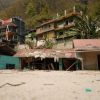Friday, April 26, 2024
News and Views from the Global South
Opinion
Unpacking 2023, the Warmest Year on Record

Credit: iStockphoto/Anil Shakya
- 2023 was the warmest year on record. The latest Copernicus Climate Change Service highlights that February 2023 to January 2024 was the first time that we experienced 12 consecutive months of temperatures 1.5-degree hotter than the pre-industrial era.
2015 to 2023 were the warmest on record in the sequence. The El Niño event of 2023 is likely to be further aggravated in 2024. El Niño typically contributes to a steep rise in global temperatures, fueling more heat on land, atmosphere and ocean, leading to an amplification of complex disaster risks.
Manifestation of 1.5-degree warming into complex climate-related disasters
The 1.5-degree warming has led to widespread heatwaves, droughts, floods, stronger cyclones and a plethora of slow-onset disasters including glacier melting, coral breaching, land degradation, and water scarcity. While temperatures may fall somewhat at the end of El Niño, the climate emergency is becoming critical.
Record-breaking heatwaves: 2023 persevered through record-breaking heat waves that affected many Asian countries. A related study by the World Weather Attribution has found that the heat wave was made at least 30 times more likely in India and Bangladesh due to climate change.
Supercharged tropical cyclones: Excessive heat in the oceans and atmosphere has been supercharging cyclones. The recent years have seen rapid intensification, curvature changes, and complex tracks of tropical cyclones both in North Indian and Southwest Pacific Ocean basins. The major cyclones of 2023, such as cyclones Mocha, Biparjoy, Typhoon Doksuri and tropical storm Jasper exemplify these trends.
Cities at risk: Coastal cities are increasingly exposed to intensifying climate hazards. Cyclone Michaung flooded India’s megacity Chennai two days before the landfall. Typhoon Doksuri, supercharged by the warmer July Pacific Ocean, made landfall in Jinjiang, China, and caused Beijing’s worst flooding in over 50 years.
Monsoonal flooding: The 2023 southwest monsoon period witnessed elevated flooding and landslides/mudslides throughout South-East Asia and South and South-West Asia. The monsoon more often deviates from its normal onset and spreads across the season due to complex interactions with the atmosphere, regional oceans and seas, and landmasses.
Economic cost of warming
In Asia and the Pacific, there were 145 reported natural hazard events in 2023 which caused over 54 thousand deaths, affected over 47 million people and caused an economic damage exceeding 45 billion dollars.
At 1.5-degree warming, ESCAP projected potential losses from disasters to be $953 billion, or 3 per cent of the regional GDP. This rises to nearly $1 trillion, or 3.1 per cent of the regional GDP under a 2-degree warming scenario. Moreover, the population at risk rises from 85 to 87 per cent when warming increases from 1.5- to 2.0- degrees (Figure 1).

ESCAP analysis observes an increasing trend of heatwaves and cyclones under both climate scenarios. In terms of absolute value, East and North-East Asia will experience the highest economic losses, whereas as a share of GDP, the Pacific small island developing States will face the most substantial losses, accounting for around 8 per cent of their GDP. This is more than double the percentage of average annual loss in the rest of Asia and the Pacific.
Key opportunities for actions
Despite the warming, 2023 fostered important milestones that are likely to help build collective resilience:
- 1. Political declaration on the midterm review of the Sendai Framework for Disaster Risk Reduction 2015–2030: The declaration was an effort to integrate risk reduction into decision-making, investment and behavior guided by an “all-of society” and “all-of-State institutions” approach.
2. The G20 New Delhi Leaders’ Declaration: Inauguration of G20 Working Group on Disaster Risk Reduction highlights accelerating progress on Early Warning and Early Action, disaster and climate resilience of infrastructure systems, and mutual learning of recovery.
3. The Loss and Damage Fund: Set up at COP28 with contributions totaling $700 million to enable grants-based support, the fund aims to balance fiscal burden and climate vulnerability.
4. The Santigo Network for loss and damage: Operationalized at COP 28, the network supports developing countries in averting, minimizing, and addressing loss and damage from climate change.
5. The UN Early Warnings for All Executive Action Plan 2023-2027: EW4All is a key adaptation pathway in our rapidly warming planet. The benefit of early warnings for all triples in vulnerable contexts.
6. Accelerating climate action in Asia-Pacific: to develop regional early warning systems backed by a regional strategy to support EW4All, build national capacities and replenishing the ESCAP Multi-Doner Trust Fund for Tsunami, Disaster and Climate Preparedness
In this regard, ESCAP’s regional strategy on empowering transboundary solutions to transboundary hazard through systematically building resilience through subregional intergovernmental institutions would be pivotal. While the warmest year reminds us that the region’s risk is outpacing resilience, the window of opportunities in 2024 offers a promise of a resilient future.
Sanjay Srivastava, Chief of Disaster Risk Reduction, United Nations Economic and Social Commission for Asia and the Pacific (ESCAP)
IPS UN Bureau

 Print
Print



